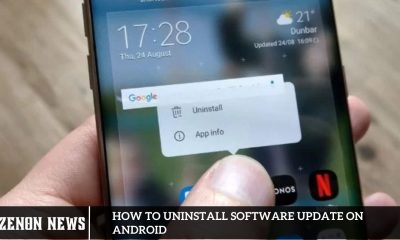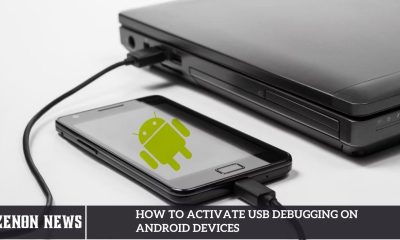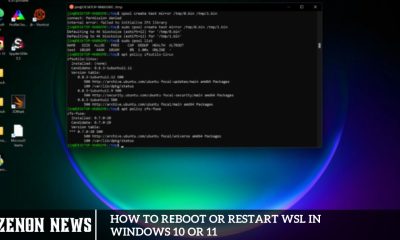News
Enhancing Smart Classes in Schools- Top Android Tablets Worth Considering

As technology progresses, tablets play a more significant role in educational environments. Thanks to their adaptability, intuitive interface, and affordability, Android tablets have become a favored choice for educators and students. This article will delve into five exceptional Android tablets ideal for modern classrooms, offering a detailed look into their features and capabilities. Let’s get started!
Tablets have become indispensable tools for educators navigating the swiftly changing educational technology landscape. In schools and academic institutions, tablets play a pivotal role by granting access to digital learning materials, enhancing interactivity, and facilitating personalized learning experiences.
Why Android Tablets for Smart Classes?
Android tablets have emerged as indispensable tools for enhancing intelligent classes in schools. Several key factors contribute to their suitability for educational environments.
Versatility: Android tablets offer a wide range of functionalities that can be tailored to suit the diverse needs of intelligent classrooms. From interactive learning apps to multimedia resources, these devices provide educators versatile tools to engage students effectively.
Accessibility: Android tablets are accessible and user-friendly, making them ideal for students of all ages and abilities. Their intuitive interfaces enable seamless navigation, ensuring students can easily access educational content and participate in classroom activities.
Affordability: Compared to other technology options, Android tablets are often more affordable, making them accessible to schools with limited budgets. This affordability allows schools to invest in multiple devices, facilitating one-to-one learning initiatives and ensuring equitable access to educational resources for all students.
Customization: Android tablets offer a high level of customization, allowing educators to tailor the device settings and applications to meet the specific needs of their students. Whether adjusting accessibility features or installing specialized educational software, Android tablets provide educators with the flexibility to create personalized learning experiences.
Integration with Google Services: Android tablets seamlessly integrate with Google services such as Google Classroom, Google Docs, and Google Drive, streamlining workflow and collaboration among students and teachers. This integration enhances productivity and facilitates seamless communication within the classroom environment.
Samsung Galaxy Tab A7 Lite
The Samsung Galaxy Tab A7 Lite emerges as a top-notch selection for intelligent classrooms in educational institutions. It features an 8.7-inch display and a sleek design, allowing students a portable and comfortable viewing experience. Powered by a robust octa-core processor, the tablet ensures seamless multitasking, swift app launches, and an overall responsive performance. Its impressive battery longevity ensures extended periods of uninterrupted learning. Furthermore, including Dolby Atmos surround sound technology enriches audio quality, rendering educational videos and online lectures more immersive. For further assistance and services, please visit Croma.
Nokia T10
Nokia offers several Android tablets, including the Nokia T10. Sporting a 10.4-inch display, this tablet provides students with a spacious digital workspace. Featuring a high-definition screen, the Nokia T10 delivers vibrant and detailed visuals, perfect for educational materials. Running on Android 11 and equipped with an octa-core processor, this tablet guarantees smooth and efficient performance.
Lenovo Tab M8
The Lenovo Tab M8 is a cost-effective Android tablet without sacrificing quality. Featuring an 8-inch HD display, it provides a clear and dynamic viewing experience. With a quad-core processor under the hood, this tablet ensures seamless performance for daily activities. Its compact design makes it effortlessly portable, catering to students’ on-the-go needs. Moreover, the Lenovo Tab M8 boasts dual speakers and Dolby Atmos support, delivering immersive audio for virtual classes or multimedia presentations.
Lenovo Tab M7
Another noteworthy addition to the lineup is the Lenovo Tab M7, tailored to meet the demands of modern classrooms. Featuring a 7-inch display, this compact tablet is an ideal choice for younger students or those who favor a smaller device. Driven by a quad-core processor, it ensures smooth and responsive performance for educational applications and online materials. With an impressive battery lifespan, lightweight construction, and robust build quality, the Lenovo Tab M7 suits students of all ages, offering durability and portability for seamless learning experiences.
I Kall N18
The I Kall N18 is a cost-effective Android tablet that offers commendable performance and functionality for smart classrooms. Its 10.1-inch display provides ample screen real estate for students to delve into educational materials. Fueled by a quad-core processor, the tablet ensures seamless operation and compatibility with educational apps. Moreover, its 4G connectivity support allows students to access online resources even in areas with limited Wi-Fi coverage. While lacking some premium features, the I Kall N18 remains a dependable choice for those on a budget.
In summary, when selecting Android tablets for intelligent classrooms in schools, it’s essential to consider factors like display size, processing capabilities, battery longevity, and additional features. Integrating these advanced tablets into classrooms can unlock new educational possibilities, engaging students in interactive and immersive learning experiences.
Providing 250 Schools with Modern Technology
In a world where technology is integral to everyday life, traditional textbooks can feel outdated to the digital-native generation. That’s why we’ve equipped numerous French students with a lightweight device that consolidates all their educational materials.
Key Achievements:
- 95% of students in the South Region of France now possess a Lenovo tablet, enhancing accessibility to digital resources.
- Over 1,200 textbooks have been digitized, promoting interactive learning experiences.
- Integration of familiar Google tools and apps has streamlined lesson comprehension.
- Virtual classrooms enable students to participate in learning activities remotely, transcending geographical barriers.
Top Android Tablets for Smart Classes
Selecting the right Android tablet is crucial when integrating technology into intelligent classrooms. Here are some top Android tablets worth considering for enhancing learning experiences:
Samsung Galaxy Tab S7+: Renowned for its stunning display and powerful performance, the Samsung Galaxy Tab S7+ is a top choice for smart classrooms. Its high-resolution screen and S Pen compatibility offer a seamless digital writing experience, making it ideal for interactive lessons and note-taking.
Lenovo Tab P11 Pro: The Lenovo Tab P11 Pro boasts a sleek design and impressive features tailored for educational use. Its vibrant OLED display and quad-speaker system enhance multimedia learning experiences, while its long battery life ensures uninterrupted use throughout the school day.
Google Pixel Slate: As a Google product, it offers seamless integration with Google Classroom and other Google services, making it a convenient choice for educators already using these platforms. Its lightweight design and versatile functionality make it suitable for various classroom activities, from research to collaborative projects.
ASUS ZenPad 3S 10: With its premium build quality and affordable price point, the ASUS ZenPad 3S 10 is a budget-friendly option for schools looking to equip classrooms with Android tablets. Its crisp display and powerful processor enable smooth multitasking, while its expandable storage ensures ample space for educational apps and resources.
Amazon Fire HD 10: While technically running a modified version of Android, the Amazon Fire HD 10 offers an affordable yet capable solution for intelligent classrooms. Its robust parental controls and access to Amazon’s vast ecosystem of educational content make it a popular choice for younger students.
Considerations for Implementing Android Tablets in Schools
Implementing Android tablets in schools requires careful planning and consideration to ensure successful integration into the learning environment. Here are some key factors to keep in mind:
Budget Constraints: Schools must consider budgetary limitations when selecting Android tablets. It is essential to choose devices that offer the best value for money without compromising on quality or performance. Additionally, schools may need to allocate funds for accessories, software licenses, and ongoing maintenance.
Training and Support: Proper training and support are crucial for educators and students to maximize the benefits of Android tablets. Schools should invest in comprehensive training programs to familiarize teachers with the devices’ features and functionalities. Additionally, technical support should be readily available to troubleshoot any issues arising during use.
Security and Privacy: Protecting student data and ensuring the security of Android tablets is paramount. Schools must implement robust security measures, such as device encryption, secure network connections, and access controls, to safeguard sensitive information. Additionally, policies should be established to address data privacy concerns and comply with relevant regulations.
Device Management: Managing a fleet of Android tablets can be challenging, especially in a school setting. Schools should implement a robust mobile device management (MDM) solution to streamline device provisioning, deployment, and maintenance. MDM software enables administrators to remotely configure settings, install updates, and monitor device usage, ensuring optimal performance and security.
Digital Citizenship: Integrating Android tablets into the curriculum allows students to learn about digital citizenship and responsible use of technology. Schools should incorporate lessons on internet safety, online etiquette, and critical thinking skills to empower students to navigate the digital world responsibly.
Key Features to Look for in Android Tablets
When selecting Android tablets for educational use in intelligent classrooms, it’s essential to consider several key features to ensure they meet the unique needs of students and educators. Here are some critical factors to look for:
Performance Metrics:
Processor: Look for tablets with powerful processors to ensure smooth operation and seamless multitasking, especially when running resource-intensive educational apps.
RAM: Tablets with sufficient RAM can handle multiple tasks simultaneously without lagging or slowing down, enhancing productivity in the classroom.
Storage: Adequate storage space is essential for storing educational content, apps, and multimedia files. Consider tablets with expandable storage options for added flexibility.
Compatibility with Educational Apps:
App Ecosystem: Choose tablets that support a wide range of educational apps and resources from reputable app stores like Google Play Store. Ensure compatibility with popular educational software used in the classroom.
Operating System: Select tablets running the latest version of the Android operating system to access the latest features and security updates, as well as ensure compatibility with new apps.
Display Quality:
Screen Size: Consider tablets with an appropriate screen size for classroom use, balancing portability with visibility. Larger screens facilitate group collaboration and multimedia presentations.
Resolution: High-resolution displays with vibrant colors and crisp visuals enhance the viewing experience, making educational content more engaging and immersive.
Battery Life and Durability:
Battery Life: Choose tablets with long battery life to withstand a full day of classroom use without frequent recharging. Extended battery life ensures uninterrupted learning experiences.
Durability: Look for tablets with sturdy construction and rugged design features that can withstand the rigors of daily use in a school environment. Features like reinforced corners and scratch-resistant screens can help prolong the device’s lifespan.
Connectivity Options:
Wi-Fi and Bluetooth: Ensure tablets have reliable Wi-Fi and Bluetooth connectivity to access online resources, connect to peripherals, and enable collaborative activities.
Ports and Expansion Slots: Consider tablets with various ports and expansion slots (e.g., USB-C, microSD) for connecting external devices, peripherals, and accessories, enhancing versatility and connectivity options.
Frequently Asked Questions
Why are Android tablets considered suitable for intelligent classes in schools?
Android tablets offer versatility, affordability, and compatibility with various educational apps, making them ideal for enhancing learning experiences in intelligent classrooms.
What features should I look for when selecting Android tablets for intelligent classrooms?
Key features include performance metrics (processor, RAM, storage), compatibility with educational apps, display quality, battery life, durability, and connectivity options.
Are there specific Android tablet models recommended for intelligent classrooms?
Some top Android tablets worth considering for smart classrooms include the Samsung Galaxy Tab S7+, Lenovo Tab P11 Pro, Google Pixel Slate, ASUS ZenPad 3S 10, and Amazon Fire HD 10.
How can Android tablets improve teaching and learning experiences in intelligent classrooms?
Android tablets facilitate interactive lessons, multimedia presentations, digital assessments, collaborative projects, and personalized learning experiences, empowering educators to engage students more effectively.
What considerations should schools keep in mind when implementing Android tablets?
Schools should consider budget constraints, training and support for educators, security and privacy measures, device management solutions, and promoting digital citizenship among students.
How can I ensure the security of Android tablets in intelligent classrooms?
Schools can implement robust security measures such as device encryption, secure network connections, access controls, and mobile device management (MDM) solutions to safeguard student data and protect against cyber threats.
Can Android tablets support remote learning initiatives?
Yes, Android tablets can support remote learning by enabling students to access educational resources, participate in virtual classrooms, collaborate with peers, and communicate with teachers from any location with internet connectivity.
What support and resources are available for educators using Android tablets in intelligent classrooms?
Educators can access online tutorials, training programs, community forums, and technical support services provided by tablet manufacturers, educational technology companies, and academic institutions to enhance their skills and troubleshoot issues.
Conclusion
Android tablets in smart classrooms present a transformative opportunity to revolutionize school teaching and learning experiences. Their versatility, affordability, and compatibility with educational apps make them indispensable tools for educators seeking to create dynamic and engaging learning environments.
By carefully considering key features such as performance metrics, compatibility with educational apps, display quality, battery life, durability, and connectivity options, educators can select Android tablets that meet the unique needs of their classrooms and students. Top models like the Samsung Galaxy Tab S7+, Lenovo Tab P11 Pro, Google Pixel Slate, ASUS ZenPad 3S 10, and Amazon Fire HD 10 offer a combination of performance, functionality, and affordability, making them ideal choices for smart classrooms.
News
White Hair and Natural Prevention Methods – Wellhealthorganic.com

Have you started noticing white strands among your once-pigmented hair? You might be wondering what’s causing this change and how to prevent it. Don’t worry; you’re in the right place! Welcome to WellHealthOrganic’s guide on understanding the causes of white hair and exploring natural prevention methods.
Imagine this scenario: you’re preparing for a special event, and a silver strand catches your eye as you glance in the mirror. While some embrace the wisdom that comes with gray hair, others may wish to preserve their youthful appearance a little longer. Regardless of your perspective, we’re here to explore the science behind this change and provide natural, practical strategies to maintain your hair’s vitality.
So, find a comfortable spot, brew a soothing cup of herbal tea, and join us on a journey to uncover the secrets of white hair and discover ways to nurture your locks with care. Your hair deserves the best, and we’re here to guide you every step of the way.
White Hair: WellHealthOrganic.com’s Guide to Causes and Natural Prevention
Imagine having a trusted resource that serves as your guide to navigating the complexities of white hair. That’s precisely what “WellHealthOrganic.com’s Guide to White Hair Causes and Natural Prevention” offers!
This website is your go-to source for understanding why your hair might be turning white and discovering easy, natural methods to prevent it. Think of it as a knowledgeable friend who shares insights on why hair changes color and how to maintain its natural hue without relying on harsh treatments.
Covering everything from the science behind white hair to practical tips for preserving your hair’s youthful appearance, this resource has it all. If you’re curious about those emerging white strands and eager to explore natural remedies, WellHealthOrganic.com is your guide.
The Importance of WellHealthOrganic.com’s Guide to White Hair Causes and Natural Prevention
Understanding why hair turns white and discovering natural prevention methods is essential for maintaining vibrant, healthy locks. Here’s why this knowledge matters:
Preserve Your Youthful Appearance:
By understanding the causes of white hair, you can take proactive measures to extend your youthful appearance. Natural prevention techniques help retain your hair’s original color, keeping you looking and feeling youthful for longer.
Empowerment Through Knowledge:
Knowledge empowers you to make informed decisions about hair care. WellHealthOrganic.com provides the information you need to manage your hair’s health confidently.
Avoid Harmful Chemicals:
Many commercial hair products contain harsh chemicals that can damage your hair. Natural prevention methods help you avoid these substances, protecting your hair and scalp.
Holistic Well-Being:
Hair care is not just about aesthetics; it’s about overall well-being. Natural methods support your health by promoting a balanced lifestyle and enhancing your overall wellness.
Boost Self-Confidence:
Maintaining your natural hair color can significantly enhance your self-esteem. Preventing premature graying through natural methods can boost your confidence and positively impact your self-image.
Sustainable Hair Care:
Natural remedies are often more eco-friendly than conventional products. By choosing natural methods, you reduce your environmental footprint and support sustainable practices.
Long-Term Hair Health:
Natural prevention focuses on nurturing your hair from within. A holistic approach promotes long-term health and vibrancy, ensuring strong and healthy hair for years.
Comprehensive Step-by-Step Guide to Natural Hair Care | WellHealthOrganic.com
Understanding White Hair Causes:
Discover the factors contributing to white hair, such as genetics, aging, and environmental influences. Understand the role of melanin, the pigment responsible for hair color, and how its gradual decline leads to the appearance of white hair.
Assessing Genetic Factors:
Explore how family history and genetics influence the onset and extent of white hair. Consider genetic insights or consult healthcare professionals to assess your risk factors.
Exploring Environmental Influences:
Identify how pollutants, UV rays, and chemical treatments can accelerate graying. Take proactive steps to minimize exposure to these harmful elements and protect your hair from damage.

Embracing Natural Prevention Methods:
Explore natural methods to prevent white hair without relying on harsh chemicals. Embrace a holistic approach with proper nutrition, stress management, and natural hair care routines.
Nourishing Your Body:
Understand how a balanced diet supports healthy hair and can help delay graying. Incorporate antioxidant-rich foods and essential nutrients to maintain hair pigmentation and overall vitality.
Managing Stress:
Recognize how stress affects hair health and contributes to premature graying. Practice relaxation techniques like meditation, yoga, and deep breathing to manage stress and support healthy hair.
Adopting Natural Hair Care Routines:
Implement gentle hair care practices, including regular washing and conditioning. Use natural products free from harsh chemicals to preserve your hair’s color and health.
Incorporating Herbal Remedies:
Explore herbal treatments like henna, amla, and sage to enhance your hair color. Experiment with homemade masks and natural remedies to strengthen and nourish your hair.
Seeking Professional Advice:
Consult a healthcare provider if you experience sudden changes in hair color. Discuss treatment options and receive personalized care tailored to your specific needs.
Extra Tips for Naturally Preventing White Hair
Stay Hydrated: Drink plenty of water to keep your hair and scalp hydrated, preventing dryness that can lead to graying.
Protect from Sun Exposure: Use hats or UV protection to shield your hair from the sun’s harmful rays.
Limit Heat Styling: Reduce heat styling tools to avoid damaging your hair.
Massage Your Scalp: Stimulate blood flow with regular scalp massages to promote healthy hair growth.
Trim Regularly: Regular trims help prevent split ends and keep your hair looking its best.
Use Gentle Accessories: Opt for accessories made from soft materials to avoid hair breakage.
Practice Patience: Natural remedies take time to show results, so be consistent and patient.
Embrace Gray Gracefully: If white hair appears, wear it confidently as a mark of experience and wisdom.
Stay Positive: Focus on maintaining healthy hair and embracing positive changes.

Advantages and Disadvantages of Natural Hair Care
Advantages:
Healthier Hair: Natural methods provide essential nutrients to nourish your hair and scalp.
Sustainable Approach: Eco-friendly practices reduce your environmental impact.
Cost-Effective: Natural remedies are often more affordable than commercial treatments.
Reduced Chemical Exposure: Avoid harsh chemicals to protect your hair’s health.
Holistic Wellness: Support overall health with a balanced lifestyle.
Customizable Solutions: Tailor natural methods to meet your individual needs.
Long-Term Benefits: Maintain your hair’s natural color and vitality over time.
Disadvantages:
Time-Consuming: Requires consistency and patience to see results.
Limited Efficacy: Results can vary based on individual factors.
Lack of Immediate Results: Natural remedies may take longer to show effects.
Need for Consistency: Requires dedication to maintain a routine.
Professional Consultation: Severe cases might need medical advice.
Cultural or Social Pressure: Societal expectations may influence decisions.
Potential Inconvenience: Additional steps and preparation compared to commercial products.
Frequently Asked Questions
What causes white hair?
A: White hair can be caused by various factors, including genetics, aging, stress, and environmental influences. The gradual decrease in melanin, the pigment responsible for hair color, is a primary factor.
Can natural methods prevent white hair?
A: Natural methods can help slow the graying process by nourishing the hair and scalp, but results may vary depending on individual factors such as genetics and overall health.
What are some effective natural remedies for preventing white hair?
A: Effective natural remedies include a balanced diet rich in antioxidants, regular scalp massages, herbal treatments like henna and amla, and a healthy lifestyle to manage stress.
How does diet impact the prevention of white hair?
A: A balanced diet supports hair health by providing essential nutrients for hair pigmentation. Foods rich in antioxidants and vitamins, such as fruits, vegetables, nuts, and seeds, are particularly beneficial.
Are there any specific herbs that can help maintain hair color?
A: Yes, herbs such as henna, amla, sage, and rosemary are known for their properties in enhancing hair color and promoting overall hair health.
How can I protect my hair from environmental damage?
A: Protect your hair from pollutants, UV rays, and harsh chemicals by wearing hats, using UV protection products, and using natural, gentle hair care products. Avoid excessive heat styling and chemical treatments.
What role does stress play in graying hair?
A: Stress can accelerate the graying process by affecting melanin production. Managing stress through relaxation techniques such as meditation, yoga, and deep breathing can help maintain hair color.
Conclusion
White hair is a natural part of aging that can be influenced by genetics, lifestyle, and environmental factors. While the appearance of white strands is often inevitable, understanding the underlying causes and exploring natural prevention methods can help maintain your hair’s health and color for as long as possible.
Adopting a holistic approach, including a balanced diet rich in essential nutrients, regular scalp massages, and herbal treatments like henna and amla, can support hair vitality. Protecting your hair from environmental damage and managing stress through relaxation techniques are crucial steps in this journey.
At WellHealthOrganic.com, we believe in the power of natural remedies and sustainable practices. Choosing gentle, eco-friendly hair care routines protects your hair from harsh chemicals and contributes to a healthier planet.
News
Key Signs of Gastroenteritis – Essential Guide from WellHealthOrganic.com

Gastroenteritis, often called stomach flu, is a common condition characterized by inflammation of the stomach and intestines. It is typically caused by infectious agents such as viruses, bacteria, or parasites, leading to significant discomfort and potential health risks.
Recognizing the critical signs of gastroenteritis, as detailed on WellHealthOrganic.com, is crucial for prompt and effective treatment. This comprehensive guide delves into the primary indicators of gastroenteritis and offers practical advice for managing and preventing the condition.
What is Gastroenteritis?
Gastroenteritis is an inflammation of the stomach lining and intestines, leading to symptoms such as diarrhea, vomiting, and abdominal cramps. It can be caused by infections from viruses (such as norovirus or rotavirus), bacteria (like Salmonella or E. coli), or parasites. Poor hygiene, contaminated food or water, and close contact with infected individuals are common ways the disease spreads.
Signs of Gastroenteritis: Insights from WellHealthOrganic.com
WellHealthOrganic.com: Key Signs of Gastroenteritis is a valuable resource designed to educate readers about the essential aspects of gastroenteritis. The article thoroughly overviews this common condition’s symptoms, causes, and treatment options. It aims to help individuals recognize and manage gastroenteritis effectively, providing insights for early detection and proper care to reduce discomfort and mitigate health risks.
Could you share how you discovered this article? Are you exploring gastroenteritis for personal knowledge or professional purposes?
Why Understanding the Key Signs of Gastroenteritis on WellHealthOrganic.com Matters
Early Detection
Identifying gastroenteritis symptoms early is crucial for prompt treatment. Early detection can help relieve symptoms more quickly, decrease the risk of dehydration, and prevent the spread of infection to others.
Prevention of Transmission
Gastroenteritis can spread quickly, mainly when caused by highly contagious viruses like norovirus and rotavirus. Knowing the signs allows individuals to implement preventive measures, helping to reduce transmission in places such as schools, workplaces, and healthcare settings.
Effective Management
Effective management of gastroenteritis involves more than alleviating symptoms. It includes ensuring proper hydration, following dietary recommendations, and recognizing when to seek medical attention. Adequate management can prevent complications and speed up recovery.
Preventing Complications
If left untreated, gastroenteritis can result in severe dehydration and other complications, especially in vulnerable groups like infants, the elderly, and those with weakened immune systems. Recognizing symptoms and responding appropriately are crucial for preventing severe health problems.
Knowing When to Seek Medical Help
Understanding the severity of symptoms helps guide informed decisions about seeking medical care. While many cases of gastroenteritis resolve on their own, severe or prolonged symptoms may necessitate medical intervention. Being well-informed empowers individuals to seek timely medical attention when necessary.

Step-by-Step Guide to Identifying Key Signs of Gastroenteritis on WellHealthOrganic.com
Recognizing Early Symptoms
Gastroenteritis commonly starts with nausea and vomiting due to stomach irritation. Persistent vomiting can result in dehydration. To manage these symptoms:
- Sip clear fluids, such as water or oral rehydration solutions, to stay hydrated.
- Avoid solid foods until the vomiting has ceased.
- Gradually reintroduce bland foods, like crackers or toast, once vomiting subsides.
Identifying Diarrhea
Diarrhea, marked by frequent loose stools, is a key symptom of gastroenteritis. To prevent dehydration and electrolyte imbalance:
- Drink plenty of fluids to replenish lost electrolytes.
- Avoid dairy, fatty, or spicy foods that can worsen diarrhea.
- Consume small, frequent meals of easily digestible foods.
Managing Abdominal Discomfort
Abdominal pain and cramps, often caused by intestinal inflammation, can be managed by:
- Apply a warm compress to the stomach to ease discomfort.
- Using over-the-counter pain relief, if recommended by a healthcare professional.
- Avoiding trigger foods that may exacerbate the pain.
Addressing Fever
A low-grade fever may occur with gastroenteritis. Manage it by:
- Taking fever-reducing medications as directed.
- Staying hydrated helps regulate body temperature.
- Resting in a comfortable and relaxed environment.
Preventing Dehydration
Dehydration is a significant concern, especially for vulnerable groups. To prevent it:
- Drink oral rehydration solutions or fluids rich in electrolytes.
- Monitor urine output and seek medical help if dehydration symptoms persist.
Seeking Medical Advice
Seek medical attention if symptoms are severe or persistent, if there is blood in vomit or stool, or if the condition affects vulnerable individuals.
Preventive Measures
Prevent gastroenteritis by practicing good hygiene and safe food handling:
- Wash hands thoroughly and handle food safely.
- Cook food thoroughly and avoid consuming undercooked meats.
- Drink clean water from safe sources.
Recovery Essentials
Recover with rest, hydration, and gradual food reintroduction:
- Rest and hydrate regularly.
- Start with bland foods like BRAT diet items (bananas, rice, applesauce, toast).
- Monitor recovery progress and adjust activity levels accordingly.
Managing Symptoms
Manage symptoms of gastroenteritis by:
- Staying hydrated.
- Eating small, easily digestible meals.
- Getting plenty of rest.
- Maintaining good hygiene.
- Monitoring the severity of symptoms.
Infectious Gastroenteritis
Viruses, bacteria, or parasites cause infectious gastroenteritis. Each type of infection occurs when the pathogen is ingested, typically through contaminated food or drink. Here are some common types of infectious gastroenteritis:
Escherichia coli Infection: Often encountered by travelers in areas with poor sanitation, this infection is caused by drinking contaminated water or eating tainted raw fruits and vegetables.
Campylobacter Infection: Found in animal feces and undercooked meat, particularly poultry, this bacterial infection results from consuming contaminated food or water, eating undercooked meat (especially chicken), or failing to wash hands after handling infected animals.
Cryptosporidium Infection: This parasitic infection, which can be contracted from swimming in contaminated pools or through contact with infected animals, spreads when parasites are transferred to food or surfaces by an infected person who hasn’t washed their hands after using the toilet.
Giardiasis: Caused by a parasitic infection of the bowel, giardiasis can be contracted by drinking contaminated water, handling infected animals, or changing the diaper of an infected baby without proper handwashing.
Salmonellosis: This bacterial infection in animal feces is spread by eating contaminated food or handling infected animals. Infected individuals can also spread bacteria to others or surfaces by not washing their hands thoroughly.
Shigellosis: Caused by bacteria in human feces, shigellosis can be transmitted when an infected person contaminates food or surfaces by not washing their hands after using the toilet.
Viral Gastroenteritis: This infection is spread through person-to-person contact, such as touching contaminated hands, feces, or vomit or by consuming contaminated food or water.
Treatment and Management of Gastroenteritis
Managing gastroenteritis involves addressing symptoms and preventing complications. Here’s how you can manage the condition:
Hydration
Drinking plenty of fluids is essential to replace lost fluids and prevent dehydration. Oral rehydration solutions (ORS) are recommended for rehydration.
Rest
Adequate rest helps the body recover from the infection and reduces symptoms.
Diet
Once vomiting subsides, start with bland, easily digestible foods such as toast, rice, and bananas. Avoid spicy, fatty, or dairy-rich foods initially.
Medications
Over-the-counter medications like anti-diarrheal drugs may be used, but it’s essential to consult a healthcare provider before use. Antiemetics may be prescribed for severe vomiting.
Preventing Spread
Practice good hygiene by washing hands thoroughly, especially after using the bathroom and before eating. Disinfect contaminated surfaces and avoid close contact with infected individuals.
Stomach Flu and Children
Children and infants are particularly vulnerable to rapid dehydration. If dehydration occurs, it’s crucial to seek medical attention immediately. Signs of dehydration in young children include:
- Sunken soft spot on the baby’s head
- Sunken eyes
- Dry mouth
- Absence of tears when crying
- Reduced urination or very little urine
- Low alertness and energy (lethargy)
- Increased irritability
Gastroenteritis, mainly when caused by a viral infection, is contagious. Children are more prone to experiencing severe symptoms, so it is essential to keep them home from daycare or school until all symptoms have resolved.
Two oral vaccines, RotaTeq and Rotarix, are available to protect against rotavirus, one of the most common causes of viral gastroenteritis. These vaccines are recommended for children starting at two months of age. Consult your doctor to determine if your child should receive these vaccines.
Before administering any medication to your child, consult with a healthcare provider. Over-the-counter drugs to control vomiting are generally not recommended for children under five years old, and medicines for diarrhea are typically not advised for those under 12 years old (some doctors may recommend avoiding these for individuals under 18).

Pros and Cons of Recognizing Gastroenteritis Symptoms
Advantages:
Early Detection and Treatment: Recognizing symptoms early allows for prompt medical intervention, potentially shortening the duration of the illness and reducing its severity.
Prevention of Complications: Awareness of symptoms enables individuals to take preventive measures, such as staying hydrated and resting, which can help prevent complications like dehydration and electrolyte imbalances.
Effective Management: Understanding symptoms facilitates better self-care, including appropriate dietary adjustments and medication use under medical guidance, to manage symptoms effectively.
Reduced Transmission: Identifying symptoms helps individuals take precautions to prevent spreading the infection, reducing transmission in settings such as schools, workplaces, and healthcare environments.
Empowerment and Preparedness: Knowledge of symptoms empowers individuals to make informed decisions about seeking medical care and managing their health, fostering a sense of preparedness and control over their condition.
Disadvantages:
Self-Diagnosis Risks: Misinterpreting symptoms or relying solely on self-diagnosis without professional confirmation can result in incorrect treatment or delayed medical attention.
Anxiety and Stress: Excessive focus on symptoms or constant monitoring may lead to unnecessary anxiety or stress, especially if symptoms are mild or transient.
Misinformation: Relying on unreliable sources or incomplete information about symptoms can cause misunderstandings and incorrect management approaches.
Varied Presentation: Gastroenteritis symptoms can vary greatly in presentation and severity, making it difficult for individuals to assess their condition without medical expertise.
Compliance Issues: Understanding symptoms does not always ensure proper adherence to treatment or preventive measures, mainly if individuals underestimate the seriousness of their condition or fail to follow medical advice.
Frequently Asked Questions
What are the common symptoms of gastroenteritis?
Common symptoms include nausea, vomiting, diarrhea, abdominal pain or cramps, and sometimes fever. These symptoms result from inflammation of the stomach and intestines.
How can I differentiate gastroenteritis from other stomach illnesses?
A combination of nausea, vomiting, diarrhea, and abdominal cramps typically characterizes Gastroenteritis. Unlike other conditions, it often follows exposure to contaminated food or water. If symptoms are severe or persistent, consult a healthcare professional for a proper diagnosis.
What causes gastroenteritis?
Gastroenteritis is usually caused by infectious agents such as viruses (e.g., norovirus, rotavirus), bacteria (e.g., Salmonella, E. coli), or parasites. It can also result from consuming contaminated food or water.
How is gastroenteritis treated?
Treatment focuses on managing symptoms and preventing dehydration. This includes drinking plenty of fluids, using oral rehydration solutions, resting, and gradually reintroducing bland foods. Over-the-counter medications may help alleviate symptoms, but severe cases may require medical attention.
When should I seek medical attention for gastroenteritis?
Seek medical attention if symptoms are severe or persistent, include blood in vomit or stool, or if you are part of a vulnerable group such as infants, the elderly, or those with weakened immune systems.
How can I prevent gastroenteritis?
Prevent gastroenteritis by practicing good hygiene, such as washing hands thoroughly, handling food safely, cooking food properly, and drinking clean water. Avoid consuming food from unreliable sources.
Can gastroenteritis be contagious?
Yes, gastroenteritis can be highly contagious, mainly when caused by viruses like norovirus and rotavirus. Practicing good hygiene and taking precautions can help prevent the spread of infection.
What are the potential complications of gastroenteritis?
Complications of gastroenteritis may include severe dehydration, electrolyte imbalances, and, in rare cases, more serious infections. It is essential to stay hydrated and seek medical help if symptoms worsen.
How can I manage gastroenteritis symptoms at home?
Manage symptoms by staying hydrated with clear fluids or oral rehydration solutions, resting, avoiding solid foods until vomiting subsides, and gradually reintroducing bland foods. Monitor your symptoms and consult a healthcare provider if needed.
What should I do if symptoms do not improve?
If symptoms do not improve or worsen over time, or if you experience severe symptoms like prolonged vomiting, diarrhea, or signs of dehydration, seek medical advice for further evaluation and treatment.
Conclusion
critical signs of gastroenteritis are crucial for effectively managing and preventing this common condition. By recognizing symptoms such as nausea, vomiting, diarrhea, and abdominal pain early, individuals can seek timely medical intervention, prevent complications, and reduce the risk of transmission to others. This essential guide from WellHealthOrganic.com provides valuable insights into identifying symptoms, managing them appropriately, and taking preventive measures. Staying informed and proactive empowers individuals to handle gastroenteritis more effectively, ensuring a quicker recovery and minimizing the impact on their overall health. Always consult a healthcare professional to ensure proper care and treatment for persistent or severe symptoms.
News
Nasik Fatafat Result Information – Complete Guide

Nasik residents, are you ready to explore “Nasik Fatafat“? Imagine this: you’re balancing work, family, and daily tasks when you suddenly remember you need groceries or have an urgent document to send.
No need to worry—Nasik Fatafat is here to help! This guide delves into what Nasik Fatafat is, why it’s a game-changer, and how it can instantly simplify your life.
Join us on a Fatafat journey and uncover the convenience it brings to vibrant Nasik!
Visit Now: Kolkata Fatafat
What is Nasik Fatafat

Nasik Fatafat is like your magical genie in a bottle, but instead of granting wishes, it helps you get things done quickly and effortlessly. This super handy service is right at your fingertips, designed to make your life easier and more convenient.
Whether you need groceries in a hurry, a delicious meal delivered to your doorstep, or important documents couriered across town, Nasik Fatafat is the go-to solution. Think of it as your personal assistant, always ready to tackle your errands swiftly and efficiently.
So, the next time you’re in a pinch or just looking to save time, remember to summon Nasik Fatafat for all your needs!
Why is Nasik Fatafat Important?
Nasik Fatafat isn’t just another service; it’s a game-changer in handling our daily tasks and responsibilities. Here’s why it’s so crucial:
Time-Saving Convenience:
In today’s fast-paced world, time is of the essence. Nasik Fatafat saves you precious time by eliminating the need to physically visit stores or run errands.
With just a few taps on your phone, you can have your groceries delivered, meals ordered, or bills paid without leaving your home or office. Nasik Fatafat is designed to make your life more convenient, giving you more time to focus on what truly matters.
Stress Reduction:
Say goodbye to the stress and hassle of rushing through crowded streets or waiting in long queues. Nasik Fatafat takes the burden off your shoulders, allowing you to focus on more important things in life.
No more worrying about forgetting essential items or missing deadlines. With Nasik Fatafat, you can rest assured that your errands are handled quickly and efficiently, helping you stay on top of your responsibilities effortlessly.
Accessibility for All:
Nasik Fatafat is designed to be inclusive and accessible to everyone, regardless of age, mobility, or busy schedules.
Whether you’re a busy professional, a parent with young children, or an elderly individual, Nasik Fatafat ensures that everyone can enjoy its benefits and convenience. This service is tailored to meet the needs of diverse users, making everyday tasks simpler and more manageable for all.
Wide Range of Services:
From grocery shopping to food delivery, from courier services to bill payments, Nasik Fatafat offers a comprehensive range of services to meet all your needs.
Whatever task you need assistance with, Nasik Fatafat has you covered, making it a versatile and indispensable tool in your daily life. With its wide array of services, Nasik Fatafat simplifies your routine, ensuring that you can manage your responsibilities effortlessly and efficiently.
Boosts Local Economy:
By patronizing local businesses and services through Nasik Fatafat, you’re contributing to the growth and sustainability of the local economy. Supporting local vendors and businesses strengthens the community and fosters a sense of solidarity and mutual support among residents.
Nasik Fatafat isn’t just about convenience; it’s about reclaiming your time, reducing stress, and supporting your local community. Next time you need a helping hand, turn to Nasik Fatafat for a quick and efficient solution!
Step-by-Step Guide to Using Nasik Fatafat
Navigating Nasik Fatafat is as easy as pie! Follow these simple steps to make the most out of this convenient service:

Download the Nasik Fatafat App:
Navigating Nasik Fatafat is as easy as pie! Follow these simple steps to make the most out of this convenient service:
Download the App: Head to your smartphone’s app store and search for “Nasik Fatafat.” Once you find the app, download and install it on your device.
Open the App: Launch the Nasik Fatafat app on your device.
Sign Up or Log In:
New Users: Upon opening the app, you’ll be prompted to sign up for an account. Enter your details to create a personalized account.
Existing Users: Log in using your existing credentials if you’re already a Nasik Fatafat user.
Set Your Location: Before you can start using the services, Nasik Fatafat needs to know your location for accurate deliveries. Allow the app to access your location or manually enter it to proceed.
Browse Services: Explore the wide range of services available, from grocery delivery to courier services.
Place an Order: Select the service you need, add items to your cart or specify the task, and place your order.
Track Your Order: Use the app to track your order in real-time, ensuring you know exactly when to expect your delivery.
Enjoy the Convenience: Sit back and relax as Nasik Fatafat takes care of your errands quickly and efficiently.
Advantages and Disadvantages of Nasik Fatafat
Advantages
| Advantages: |
| Time-Saving Convenience: |
| Nasik Fatafat saves you valuable time by eliminating need to physically visit stores or run errands yourself. |
| With just a few taps on your smartphone, you can complete tasks quickly and efficiently, freeing up time for other activities. |
| Stress Reduction: |
| Say goodbye to the stress of rushing through crowded streets or waiting in long queues. |
| Nasik Fatafat simplifies your life by handling errands and deliveries, allowing you to focus on more important aspects of your day. |
| Wide Range of Services: |
| Nasik Fatafat saves you valuable time by eliminating the need to physically visit stores or run errands. |
| From grocery shopping to food delivery, from courier services to bill payments, Nasik Fatafat offers diverse services to meet your needs. |
| Accessibility for All: |
| Nasik Fatafat is designed to be inclusive and accessible to everyone, regardless of age, mobility, or busy schedules. |
| It provides a convenient solution for individuals with limited mobility or those unable to run errands themselves. |
| Supports Local Businesses: |
| By using Nasik Fatafat, you’re supporting local businesses and vendors in your community. |
| It fosters economic growth and sustainability by promoting local commerce and reducing reliance on multinational corporations. |
Disadvantages:
| Disadvantages: |
| Dependency Risk: |
| Over-reliance on Nasik Fatafat may lead to decreased self-reliance and independence. |
| It’s essential to strike a balance and not become overly dependent on the service for everyday tasks. |
| Service Limitations: |
| Not all services may be available in every area covered by Nasik Fatafat. |
| Depending on location and availability, certain products or services may have restrictions or limitations. |
| Additional Costs: |
| While the convenience of Nasik Fatafat is undeniable, some services may come with additional costs or fees. |
| It’s essential to consider these potential expenses when using the service regularly. |
| Reliability Concerns: |
| While Nasik Fatafat strives for efficiency and reliability, occasional delays or issues may occur. |
| Certain products or services may have restrictions or limitations depending on location and availability. |
| Privacy and Security Risks: |
Providing
personal information and payment details when using Nasik Fatafat may pose privacy and security risks. |
| It’s crucial to ensure that the platform adheres to strict security measures to protect user data from unauthorized access or breaches. |
While Nasik Fatafat offers many advantages in convenience and efficiency, it’s crucial to weigh these benefits against potential drawbacks. Use the service responsibly to maximize its benefits while minimizing any risks.
Frequently Asked Question
What is Nasik Fatafat?
Nasik Fatafat is a convenient service that offers a range of solutions, from grocery shopping and food delivery to courier services and bill payments, all accessible through a mobile app.
How do I get started with Nasik Fatafat?
To get started, download the Nasik Fatafat app from your smartphone’s app store, sign up for an account or log in if you’re an existing user, set your location, and start exploring the services available.
How do I download the Nasik Fatafat app?
Head to your smartphone’s app store, search for “Nasik Fatafat,” and download and install the app on your device.
How do I sign up for Nasik Fatafat?
Upon opening the app, new users will be prompted to sign up for an account. Enter your details to create a personalized account. Existing users can log in using their credentials.
Why does Nasik Fatafat need my location?
Nasik Fatafat needs your location to provide accurate delivery services. You can either allow the app to access your location automatically or manually enter it.
What services does Nasik Fatafat offer?
Nasik Fatafat offers a wide range of services, including grocery delivery, food delivery, courier services, and bill payments.
How do I place an order on Nasik Fatafat?
Browse the available services, select the one you need, add items to your cart or specify the task, and place your order through the app.
Conclusion
Nasik Fatafat is your go-to solution for making daily tasks easier and more efficient. With a comprehensive range of services, from grocery shopping and food delivery to courier services and bill payments, Nasik Fatafat brings convenience right to your fingertips.
By supporting local businesses and ensuring timely and accurate deliveries, Nasik Fatafat not only saves you valuable time but also contributes to the growth and sustainability of the local economy. While enjoying the benefits of this versatile service, it’s essential to use it responsibly to maximize its advantages and minimize any potential drawbacks.
Whether you’re a busy professional, a parent, or an elderly individual, Nasik Fatafat caters to everyone’s needs, making it an indispensable tool in your daily life. Download the app today, and let Nasik Fatafat handle your errands with efficiency and ease, allowing you to focus on what truly matters.
-
![Fix Keyboard Not Working in Windows 10 [Tested Methods]](https://zenonnews.com/wp-content/uploads/2024/05/Fix-Keyboard-Not-Working-in-Windows-10-Tested-Methods-400x240.jpg)
![Fix Keyboard Not Working in Windows 10 [Tested Methods]](https://zenonnews.com/wp-content/uploads/2024/05/Fix-Keyboard-Not-Working-in-Windows-10-Tested-Methods-80x80.jpg) Windows4 months ago
Windows4 months agoFix Keyboard Not Working in Windows 10 [Tested Methods]
-

 Windows5 months ago
Windows5 months agoHow to Type pi π symbol on Windows, iOS and Android
-

 How To5 months ago
How To5 months agoHow to Uninstall Software Update On Android
-

 Social Media5 months ago
Social Media5 months agoHow to Use Facebook Marketplace Without an Account
-

 How To5 months ago
How To5 months agoHow to Activate USB Debugging on Android Devices
-

 Windows5 months ago
Windows5 months agoHow to Unlock Dell Laptop Keyboard on Windows 10/11
-

 Windows5 months ago
Windows5 months agoHow to Rеboot or Restart WSL in Windows 10 or 11
-

 Apps4 months ago
Apps4 months agoYouTube Premium Apk v19.18.34 (Premium Unlocked, No Ads, Many More)












